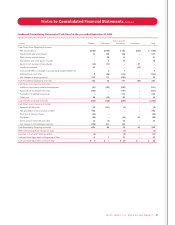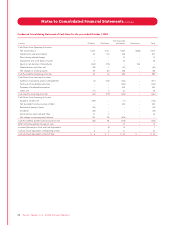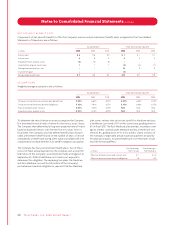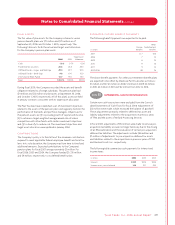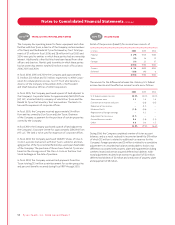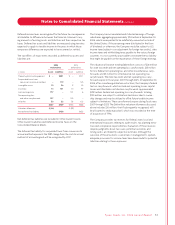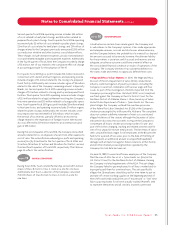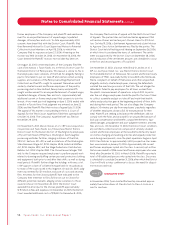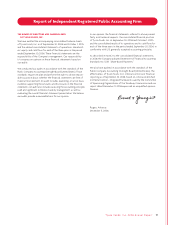Tyson Foods 2006 Annual Report Download - page 53
Download and view the complete annual report
Please find page 53 of the 2006 Tyson Foods annual report below. You can navigate through the pages in the report by either clicking on the pages listed below, or by using the keyword search tool below to find specific information within the annual report.
Deferred income taxes are recognized for the future tax consequences
attributable to differences between the financial statement carry-
ing amounts of existing assets and liabilities and their respective tax
bases. Deferred tax assets and liabilities are measured using tax rates
expected to apply to taxable income in the years in which those
temporary differences are expected to be recovered or settled.
The tax effects of major items recorded as deferred tax assets and
liabilities are:
2006 2005
Deferred Tax Deferred Tax
in millions Assets Liabilities Assets Liabilities
Property, plant and equipment $ – $481 $ – $511
Suspended taxes from
conversion to accrual method –119 – 125
Intangible assets 10 26 9 25
Inventory13 101 10 97
Accrued expenses 177 –131 6
Net operating loss
and other carryforwards 137 –125 –
All other 50 22 58 122
$387 $749 $ 333 $886
Valuation allowance $ (66) $(99)
Net deferred tax liability $428 $652
Net deferred tax liabilities are included in Other Current Assets,
Other Current Liabilities and Deferred Income Taxes on the
Consolidated Balance Sheets.
The deferred tax liability for suspended taxes from conversion to
accrual method represents the 1987 change from the cash to accrual
method of accounting and will be recognized by 2017.
The Company has accumulated undistributed earnings of foreign
subsidiaries aggregating approximately $153 million at September 30,
2006, which are expected to be indefinitely reinvested outside of
the United States. If those earnings were distributed in the form
of dividends or otherwise, the Company would be subject to U.S.
income taxes (subject to an adjustment for foreign tax credits), state
income taxes and withholding taxes payable to the various foreign
countries. It is not currently practicable to estimate the tax liability
that might be payable on the repatriation of these foreign earnings.
The valuation allowance totaling $66 million consists of $26 million
for state tax credit and net operating loss carryforwards, $35 million
for U.S. federal net operating loss and other miscellaneous carry-
forwards and $5 million for international net operating loss
carryforwards. The state tax credit and net operating loss carry-
forwards expire in fiscal years 2007 through 2025. At September 30,
2006, after considering utilization restrictions, the Company’s federal
tax loss carryforwards, which include net operating losses, capital
losses and charitable contribution carryforwards, approximated
$259 million. Federal net operating loss carryforwards totaling
$120 million, are subject to utilization limitations due to owner-
ship changes and may be utilized to offset future taxable income
subject to limitations. Thesecarryforwards expire during fiscal years
2007 through 2025. The $66 million valuation allowance discussed
above includes $30 million, that if subsequently recognized, will
be allocated to reduce goodwill, which was recorded at the time
of acquisition of TFM.
The Company provides tax reserves for federal, state, local and
international exposures relating to audit results, tax planning initia-
tives and compliance responsibilities. Evaluation of these reserves
requires judgments about tax issues, potential outcomes and
timing, and is an inherently subjective estimate. Although the
outcome of these tax items is uncertain, in management’s opinion,
adequate provisions for income taxes have been made for potential
liabilities relating to these exposures.
Ty s on Foods, Inc. 2006 Annual Report51
Notes to Consolidated Financial Statements continued


